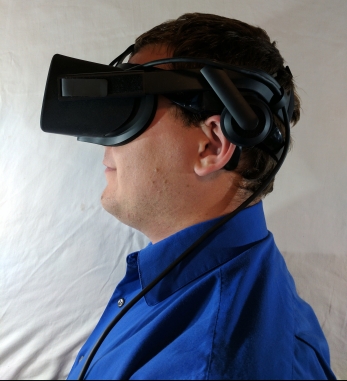Telek utilizes two technologies that have recently hit consumer market in a meaningful way: EEG and virtual reality.
EEG

EEG, or electroencephalogram, is a device that detects brainwaves. A brief physiology lesson: your nervous system is a circuit. Electricity is coursing through your body right now in tiny, controlled sparks. These sparks, as with any electrical current, produce a mild magnetic field around them. These fields can be detected by electrodes, which are essentially small bits of metal attached to wires. Electrodes are placed on the head (where there are lots of sparks) and ear (where there are relatively few sparks) to compare the difference between the two areas. This difference is what is known as a brainwave. Your brainwave spectrum is something like a fingerprint; each person’s spectrum is uniquely their own, to an extent. Telek does not record or store your brainwaves, so your unique identity is safely in your own head.
From these brainwaves, an EEG can determine your level of engagement, your emotional state, or even your cognitive load. An EEG cannot read thoughts, but intention can be derived from your brainwaves. Telek currently only utilizes brainwave differentials: one set of waves is a neutral state, while another is an action state. We plan to use other metrics in the future.
Virtual Reality

Virtual reality head mounted devices combine head tracking technologies with low energy screens to give you a feeling of being able to look around a computer generated environment.
The head tracking portion of this technology is achieved in a few different ways depending on the device. The HTC Vive uses lasers from a pair of “light houses” to track both head and a pair of wands, giving you sub-millimeter accuracy. PlayStation VR uses computer vision to track a shape and color, specifically a blue sphere that is attached to the headset and controllers. Oculus Rift and FOVE use infrared camera to identify and track the headset and any accessories. At Telek, we find the Oculus Rift gives our customers the best experience for our application.
The screens in all of the headsets above are OLED screens, or organic light emitting diode screens. Traditional, incandescent light bulbs use electricity to heat a filament to white hot, producing light from heat. LEDs in your computer screen use different layers of material to produce light when electricity flows through them. Organic LEDs, OLEDs for short, use carbon-based materials to produce near heat-less light at minimal energy levels. Other advantages include light weight and physically flexible. These advantages combine to make two screens that are light enough and efficient enough to run off a computer and directly on your head.